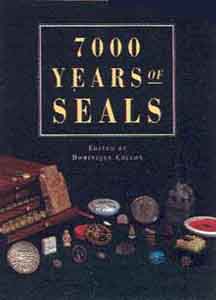
Dictionary of the Ancient Near East
Piotr Bienkowski and Alan Millard, eds.
(Philadelphia: University of Pennsylvania Press, 2000) 342 pp., $49.95
The next time you recommend “the hair of the dog” to someone nursing a hangover, you might nonchalantly add that the treatment was first mentioned in an Ugaritic text from the Late Bronze Age. Remedies for drunkenness, Hittite law codes, the role of eunuchs in Assyrian society and Mesopotamian dream interpretation—along with the more usual topics of architecture, religion, literature, culture and economics—are all briefly addressed in this new reference book about the various cultures of the ancient Near East. Edited by 12 scholars of international standing, the dictionary contains some 500 entries—from “Achaemenids” to “Ziwiye” (a site in modern Iran)—and black-and-white photographs and maps.

7000 Years of Seals
Dominique Collon, ed.
(London: British Museum, 1997) 240 pp., $35
For thousands of years, merchants, priests and kings have staked claim to their possessions and authorized their contracts and letters by marking them with seals. Often made of precious stones such as lapis lazuli or carnelian, seals and their impressions are valuable sources of information about the ancient world—telling us, for instance, about ancient trade routes and the kinds of goods that were shipped. In this volume, 13 scholars discuss seals from all over the world, and from Neolithic to modern times.

Encyclopedic Dictionary of Archaeology
Barbara Ann Kipfer
(New York: Kluwer Academic/ Plenum Publishers, 2000) 708 pp., $150
Barbara Kipfer’s comprehensive new dictionary is what its title promises: a concise, condensed manual for all things archaeological. Its large typeface and uncluttered design make for easy reading, but for the hefty price of $150 you might expect at least some illustrations. The definition of “Corinthian order,” for example, would certainly have benefited by a drawing of a Corinthian column. On the other hand, Kipfer has included a whole wealth of terms and topics that have tangential, yet meaningful, relationships with the world of archaeology. For instance, an entry on Claude Lévi-Strauss, the modern French anthropologist, is sandwiched between “levigated” (purified by sedimentation) and “Levkas” (one of the Ionian Islands). This sort of far-ranging inclusiveness is typical of the volume’s 7,000 entries. An appended timeline, which traces the development of writing over the millennia, is another attractive feature of this new dictionary.
Religions of Rome
Mary Beard, John North and Simon Price
(New York: Cambridge University Press, 1998) vol. 1, 454 PP.; vol. 2, 416 pp.; each volume $69.95 hardback, $24.95 paperback
The evolution of Roman religious worship over 1,200 years, from polytheism to Christianity, is thoroughly examined in this two-volume set. Volume 1 provides descriptions and histories of various cults; volume 2 serves as a source book for the earlier volume, containing extracts from literary documents and photographs of paintings, sculptures, household shrines, coins and inscriptions. One particularly interesting chapter discusses such holidays as the Parilia (concerned with the well-being of flocks and herds), the Saturnalia (marked by sacrifices and banqueting at the temple of Saturn, as well as topsy-turvy feasts in which slaves were wined and dined) and the Lupercalia (when scantily clad young men danced around and lashed bystanders with thongs—the latter a festival particularly vexing to the fifth-century A.D. bishop of Rome.

Dictionary of New Testament Background
Craig A. Evans and Stanley E. Porter, eds.
(Downers Grove, Il: Intervarsity Press, 2000) 1,328 pp., $39.99
The New Testament is best understood in the context of the Jewish and Greco-Roman world that gave birth to the early Christian church. With the publication of this volume (the fourth in a series of dictionaries on New Testament themes), readers will find it easy to delve into background material on subjects that range from Adam and Eve to the Zealots, with entries on Greek gymnasiums and Rabbinic proverbs in between. The entries are manageable in length—usually 1,000 to 7,500 words—and are written by notable historians and scholars. This reference book makes it easy to delve into the cross-currents of 2,000-year-old Mediterranean culture.

